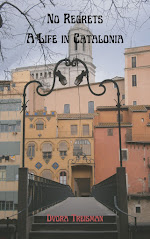The other day the ants must have gotten the better of him, for he asked me if I had ever been to Sant Quirze de Colera, probably guessing that I had never even heard of it. A medieval monastery that sits in its own small valley in the foothills of the Pyrenees is something one does want to see.
You get there by driving down a small local highway that has no number, and turning onto another even smaller road that turns into a dirt road. Not to worry. If you go slow enough and watch out for the large holes and big rocks, you’ll be just fine.
The ride was lovely. At the road’s end, in a small valley sat this spectacular 12th century romanesque complex: church, cloister, monastery, and a separate parish church. The original benedictine community settled there at the end of the 8th century; the original church was built in the 10th. Already in partial ruins, in 1592 it was closed and in 1598 it was sold and was turned into a farm. It remained in that family until 1994. Sitting within the town limits of Rabós, the family then ceded the property to the town.
 |
| The parish church of Santa Maria |
 |
| Cloister |
 |
| Church of Sant Quirze interior |
When we Americans think of a building being old, we think 200 years. In Europe, those numbers are very different, but people here take it for granted. Our apartment in Tarragona looked out at the old Roman wall of the city. It was built in the 2nd century B.C. The church of Sant Pere, here in Figueres, just celebrated it’s 1000th anniversary. For that matter, Josep’s family has lived here for many generations. On his mother’s side, the family comes from Vilajuiga, not far from Rabós. The name means Jewish town and his mother used to always say (or joke) that the family is probably Jewish. That is probably even more intriguing than a medieval monastery sitting in the foothills of the Pyrenees.
(Photos taken with my cell phone)




















No comments:
Post a Comment